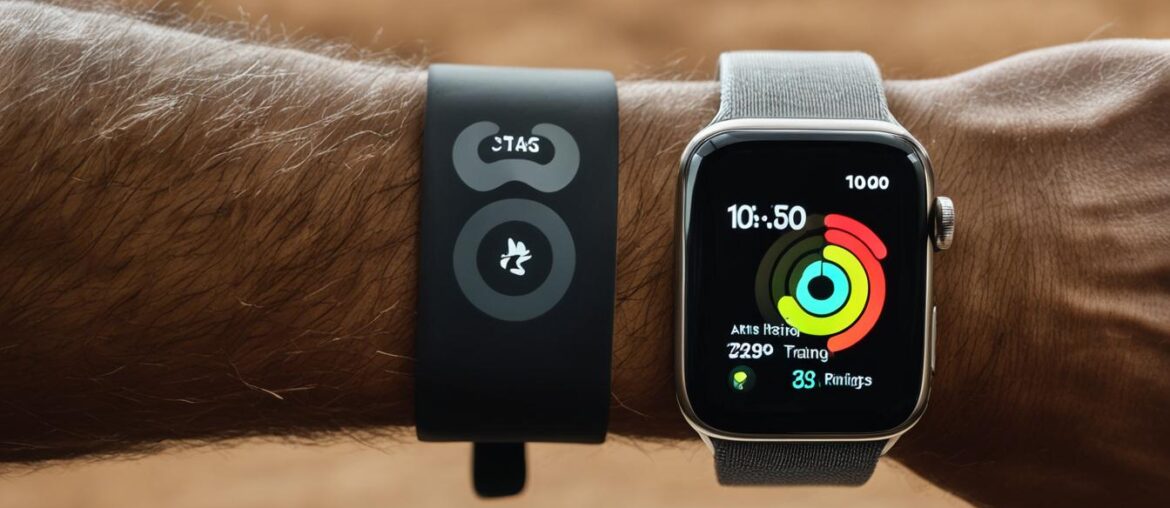The Apple Watch is a versatile fitness tracker that offers a wide range of features for tracking workouts. While it excels in many areas of fitness, using the Apple Watch for strength training may require some additional efforts. In this article, I will guide you on how to effectively utilize your Apple Watch for functional strength training, enabling you to maximize your fitness routine and achieve your goals.
Key Takeaways:
- Using the Apple Watch for strength training requires some adjustments and alternative methods.
- Tracking strength training workouts can be done through manual logging with Voice Memos or using third-party apps.
- To ensure accurate workout tracking, it’s important to calibrate your Apple Watch and optimize its settings.
- Popular third-party apps like Fitbod, Gymaholic, and Strong are available for enhanced workout tracking on the Apple Watch.
- By utilizing these tips and tools, you can make the most of your Apple Watch for strength training and optimize your fitness routine.
Tracking Workouts with the Apple Watch
The ability to track your workouts is essential for progress in strength training. While the Apple Watch has built-in workout tracking features, they are not specifically tailored for strength training. The recorded data focuses on general metrics like calories burned and heart rate rather than tracking reps, sets, and weight lifted. However, there are alternative methods and third-party apps that can help you log and track your strength training workouts effectively.
If you’re looking for a more comprehensive tracking experience for your strength training sessions, third-party apps can bridge the gap left by the Apple Watch’s built-in features. These apps offer specialized functionality, allowing you to track reps, sets, weights, and even customize your workout programs. Popular options include:
- Fitbod
- Gymaholic
- Strong
These apps provide a more detailed and tailored approach to tracking your strength training workouts. With features specifically designed for strength training, you can easily monitor and record your progress, helping you stay motivated and accountable.
In addition to third-party apps, you can also use manual logging methods to track your workouts with the Apple Watch. One simple approach is to utilize the Voice Memos app. By recording your lifted totals during your workout, you can easily log your sets and reps after your training session. While this method may require a bit more effort and lacks immediate access to past lifts, it offers a convenient alternative to traditional pen and paper tracking.
To give you a visual idea of how third-party apps and manual logging can enhance your workout tracking experience with the Apple Watch, check out the table below:
| Features | Apple Watch Built-in | Third-Party Apps | Manual Logging |
|---|---|---|---|
| Reps Tracking | No | Yes | Yes |
| Sets Tracking | No | Yes | Yes |
| Weight Tracking | No | Yes | Yes |
| Customized Workouts | No | Yes | No |
| Easy Logging | Yes | Yes | No |
As you can see, third-party apps and manual logging can provide additional features and flexibility compared to the Apple Watch’s built-in workout tracking. By utilizing these methods, you can efficiently track your strength training workouts, monitor your progress, and achieve your fitness goals.
Next, we will explore how to use the Voice Memos app for manual logging of your strength training workouts. Stay tuned!
Manual Logging with Voice Memos
![]()
If you prefer a simple and straightforward approach to track your strength training workouts, you can utilize the Voice Memos app on your Apple Watch.
By recording your lifted totals during your workout, you can easily log your sets and reps after your training session.
This method requires some dedication to tracking and lacks immediate access to past lifts, but it offers a convenient alternative to traditional pen and paper tracking.
During your workout, a quick tap on your Apple Watch can initiate the recording in the Voice Memos app. Speak clearly to note down the number of reps, sets, and weights lifted as you go through your strength training routine.
Once you finish your session, simply stop the recording and label it with the appropriate workout details. This way, you create an audio log that captures all the necessary information for future reference.
While manual logging with Voice Memos may not provide the same level of convenience as automated workout tracking, it offers a personal touch and the flexibility to record additional notes or observations about your training session.
Third-Party Apps for Enhanced Workout Tracking
To enhance your workout tracking experience with your Apple Watch, there are several third-party apps available that cater specifically to strength training. These apps offer a range of features designed to help you monitor and record your strength training sessions more effectively.
One popular option is Fitbod. This app provides comprehensive tracking capabilities, allowing you to log and track your reps, sets, and weight lifted. Fitbod also offers personalized workout programs based on your fitness level and goals, making it a valuable tool for anyone looking to improve their strength training routine.
Gymaholic is another great choice for Apple Watch users. This app allows you to track your strength training workouts with ease. You can log the details of each exercise, including reps, sets, and weight, and the app will generate detailed workout summaries for you to review. Gymaholic also provides instructional videos to ensure you are performing exercises correctly and safely.
For those who prefer a more customizable approach to their strength training, Strong is an excellent option. This app allows you to create and track your own workouts, making it easy to tailor your training to your specific needs and preferences. With Strong, you can track reps, sets, and weight lifted, and analyze your progress over time.
| Third-Party App | Features |
|---|---|
| Fitbod | – Tracking reps, sets, and weight lifted – Personalized workout programs |
| Gymaholic | – Detailed exercise logging – Workout summaries – Instructional videos |
| Strong | – Customizable workouts – Tracking reps, sets, and weight lifted – Progress analysis |
By utilizing these third-party apps, you can take your workout tracking to the next level and optimize your strength training sessions with your Apple Watch. Whether you prefer a personalized program, detailed exercise logging, or a customizable approach, there is an app available to suit your needs and help you achieve your fitness goals.
“Tracking your strength training workouts has never been easier with these third-party apps for the Apple Watch.”
Calibrating Your Apple Watch for Accuracy

Calibrating your Apple Watch is essential to ensure accurate tracking of your workouts, including strength training. By calibrating your watch, you can improve the accuracy of distance, pace, and calorie measurements, allowing for a more precise understanding of your workout performance.
To calibrate your Apple Watch for workout accuracy, follow these steps:
- Wear your Apple Watch during an outdoor walk or run.
- Ensure that your iPhone is also with you.
- Walk or run at your normal pace for at least 20 minutes.
- The Apple Watch will automatically learn your stride length at different speeds and optimize its calculations for future workouts.
Calibrating your Apple Watch can help it understand your fitness level and provide more accurate metrics, allowing you to track your strength training progress more effectively.
| Benefits of Calibrating Your Apple Watch | Tips for Calibrating Your Apple Watch |
|---|---|
|
|
Optimizing Apple Watch Settings for Workout Tracking
To ensure your Apple Watch accurately tracks your workouts, it’s important to optimize certain settings. By following these steps, you can improve the accuracy and effectiveness of your workout tracking on your Apple Watch.
Enable Location Services and Motion Calibration & Distance
Enabling Location Services and Motion Calibration & Distance on your iPhone is essential for providing the necessary information to your Apple Watch. Location Services allows the watch to utilize GPS data for outdoor activities, while Motion Calibration & Distance ensures accurate tracking of your movement during workouts.
To enable Location Services:
- Open the Settings app on your iPhone.
- Scroll down and select “Privacy”.
- Tap on “Location Services”.
- Make sure the toggle switch is turned on.
To enable Motion Calibration & Distance:
- Open the Settings app on your iPhone.
- Select “Privacy”.
- Tap on “Motion & Fitness”.
- Ensure that the toggle switch for “Fitness Tracking” is turned on.
Adjust Personal Information in the Health App
Adjusting your personal information in the Health app on your iPhone can help the Apple Watch calculate more accurate calorie burn and activity data. By providing accurate details about your height, weight, gender, and age, you can ensure that the Apple Watch provides tailored and precise fitness metrics.
To adjust personal information:
- Open the Health app on your iPhone.
- Tap on the “Profile” tab located at the bottom right corner.
- Select “Edit” at the top right corner.
- Update your personal information accordingly.
By optimizing these settings on your Apple Watch, you can enhance the accuracy and reliability of your workout tracking. This allows you to make informed decisions about your fitness routine and achieve your fitness goals more effectively.
Conclusion
In conclusion, the Apple Watch can be a valuable tool for strength training, even though its built-in workout tracking features may not cater specifically to this discipline. However, by implementing manual logging with Voice Memos and utilizing third-party apps, you can overcome this limitation and track your strength training workouts effectively. Additionally, calibrating your Apple Watch and optimizing settings will ensure accurate tracking and provide you with more precise metrics.
By following these tips and utilizing the available tools, you can optimize your fitness routine and maximize the benefits of your Apple Watch for strength training. Whether you prefer the simplicity of manual logging or the advanced features offered by third-party apps, there are options available to suit your needs and preferences. Take advantage of the Apple Watch’s capabilities and make the most of your strength training sessions.
Remember, the key to achieving your fitness goals is consistency and tracking your progress. With the Apple Watch and the techniques mentioned in this article, you can stay on top of your strength training routine and make informed decisions to enhance your performance. So, put your Apple Watch to good use, track your workouts, and watch your strength and fitness levels improve over time.




